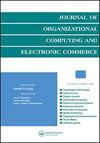CAN CYBER RISK OF HEALTH CARE FIRMS BE INSURED? A MULTINOMIAL LOGISTIC REGRESSION MODEL
IF 1.9
4区 管理学
Q3 COMPUTER SCIENCE, INFORMATION SYSTEMS
Journal of Organizational Computing and Electronic Commerce
Pub Date : 2023-04-03
DOI:10.1080/10919392.2023.2244386
引用次数: 1
Abstract
ABSTRACT The healthcare sector is prone to Distributed Denial-of-Service and Ransomware attacks owing to unsecured networks and software. This results in stalling of outpatient and inpatient operations of a hospital. In this study, we propose an H-CRAM model that computes the risk of a cyber-attack based on the threat appraisal component of the Protection Motivation Theory (PMT) using multinomial logistic regression. We also hypothesize that training the healthcare staff, implementing IT governance, and intervening technology will decrease the probability of the occurrence of a cyber threat. The severity of the risk is computed using Collective Risk Modelling. Next, based on the coping appraisal component of PMT, Rational Choice Theory, and NIST guidelines, we propose that the CIO of a healthcare firm should first reduce the cyber-risk by investing in encrypting Electronic Health Records, Security Incident and Event Management (SIEM) and Security Orchestration, Automation and Response (SOAR) tools. Then pass the residual cyber risk to a cyber insurer.医疗保健公司的网络风险可以投保吗?一个多项逻辑回归模型
由于不安全的网络和软件,医疗保健部门容易受到分布式拒绝服务和勒索软件攻击。这导致医院门诊和住院手术的拖延。在这项研究中,我们提出了一个H-CRAM模型,该模型基于保护动机理论(PMT)的威胁评估组件,使用多项逻辑回归计算网络攻击的风险。我们还假设,培训医疗保健人员、实施IT治理和干预技术将降低网络威胁发生的可能性。使用集体风险模型计算风险的严重程度。接下来,基于PMT的应对评估组件、理性选择理论和NIST指南,我们建议医疗保健公司的CIO应该首先通过投资加密电子健康记录、安全事件和事件管理(SIEM)和安全编排、自动化和响应(SOAR)工具来降低网络风险。然后将剩余的网络风险转交给网络保险公司。
本文章由计算机程序翻译,如有差异,请以英文原文为准。
求助全文
约1分钟内获得全文
求助全文
来源期刊

Journal of Organizational Computing and Electronic Commerce
工程技术-计算机:跨学科应用
CiteScore
5.80
自引率
17.20%
发文量
7
审稿时长
>12 weeks
期刊介绍:
The aim of the Journal of Organizational Computing and Electronic Commerce (JOCEC) is to publish quality, fresh, and innovative work that will make a difference for future research and practice rather than focusing on well-established research areas.
JOCEC publishes original research that explores the relationships between computer/communication technology and the design, operations, and performance of organizations. This includes implications of the technologies for organizational structure and dynamics, technological advances to keep pace with changes of organizations and their environments, emerging technological possibilities for improving organizational performance, and the many facets of electronic business.
Theoretical, experimental, survey, and design science research are all welcome and might look at:
• E-commerce
• Collaborative commerce
• Interorganizational systems
• Enterprise systems
• Supply chain technologies
• Computer-supported cooperative work
• Computer-aided coordination
• Economics of organizational computing
• Technologies for organizational learning
• Behavioral aspects of organizational computing.
 求助内容:
求助内容: 应助结果提醒方式:
应助结果提醒方式:


